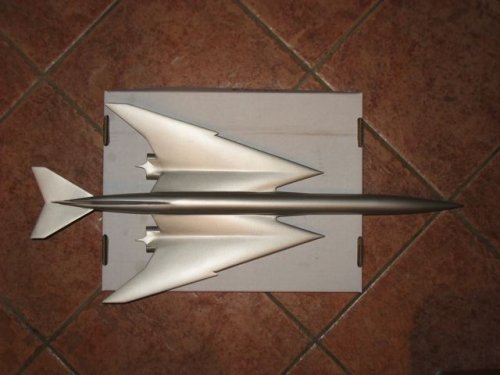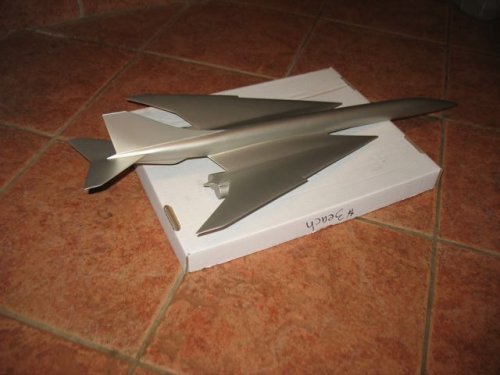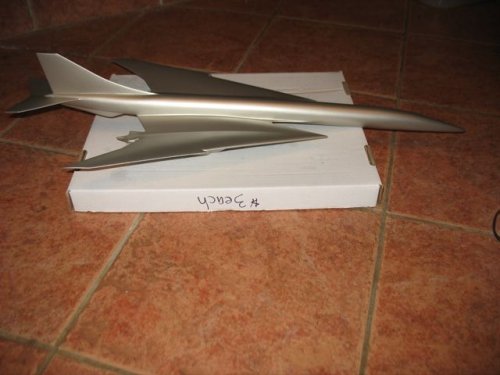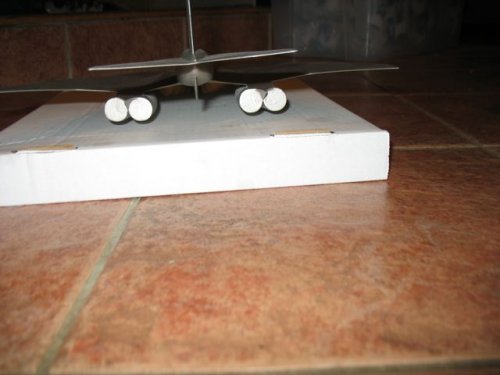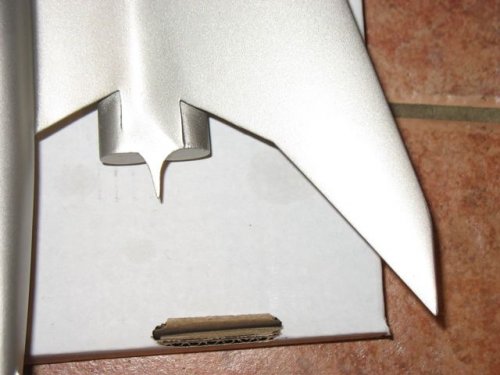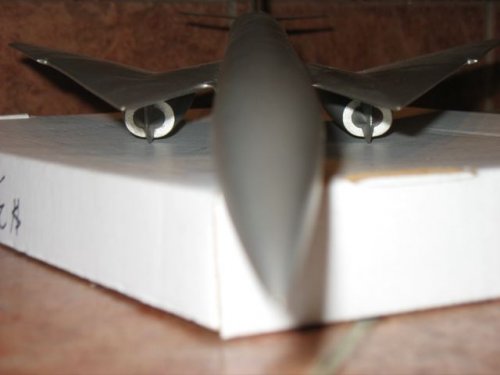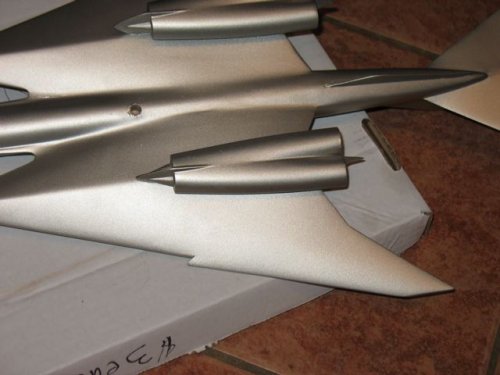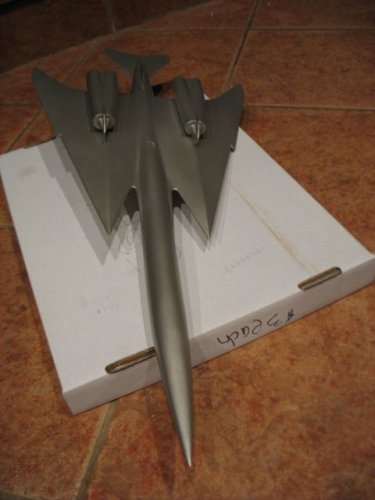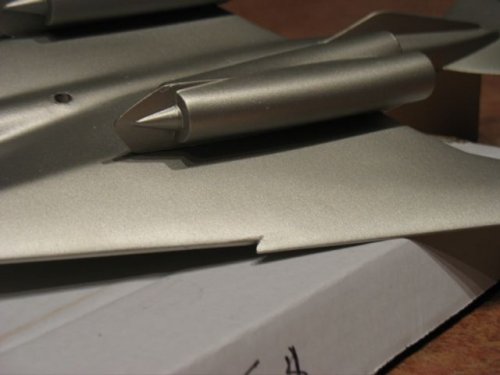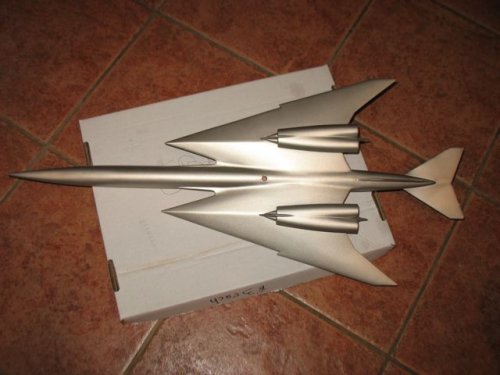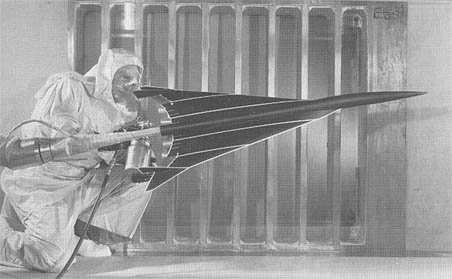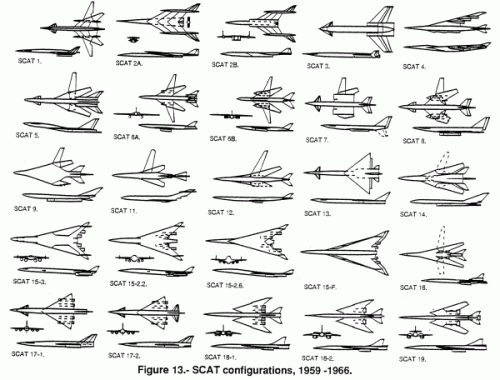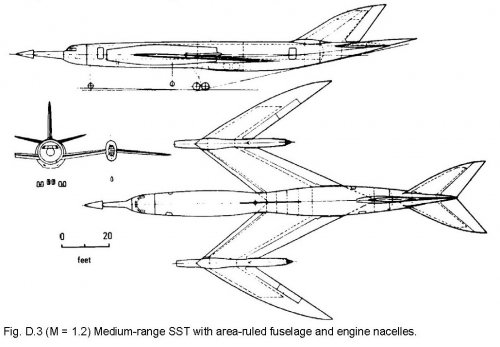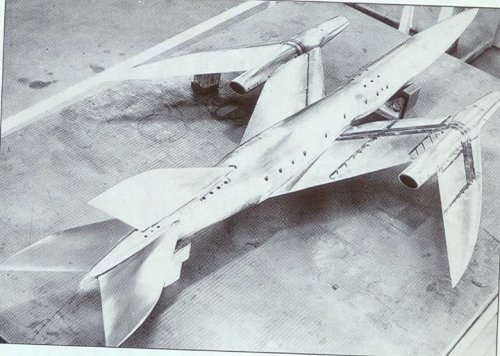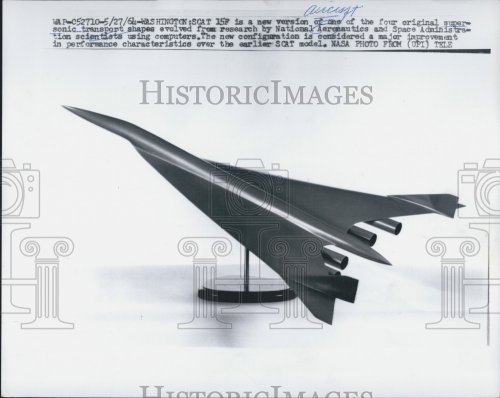I recieved photos of a display model yesterday. The only hints as to identity is that the model comes from the estate of an aeronautical engineer from Georgia... thus "Lockheed" springs immediately behind. But the tail looks suspiciously Boeing-SST. Anybody ever see this beastie before?
You are using an out of date browser. It may not display this or other websites correctly.
You should upgrade or use an alternative browser.
You should upgrade or use an alternative browser.
SCAT-18 SST
- Thread starter Orionblamblam
- Start date
SCAT-18 SST
The remaining photos. My guess is that this is an early/mid 1960's Lockheed SST design. It's just bizarre enough to be from those early experimental days, and it just doesn't have that "bomber feel" to it.
I have the slightest hint of recognition with it, I *think* from a NASA wind tunnel report. But I can't place it.
SCAT-18 SST
The remaining photos. My guess is that this is an early/mid 1960's Lockheed SST design. It's just bizarre enough to be from those early experimental days, and it just doesn't have that "bomber feel" to it.
I have the slightest hint of recognition with it, I *think* from a NASA wind tunnel report. But I can't place it.
SCAT-18 SST
Attachments
SCAT-18 SST
D'oh. I knew as soon as I asked publicly, I'd figure it out. It's probably a SCAT-18. Now looking for a decent drawing...
D'oh. I knew as soon as I asked publicly, I'd figure it out. It's probably a SCAT-18. Now looking for a decent drawing...
- Joined
- 13 June 2007
- Messages
- 2,173
- Reaction score
- 3,095
Very nice - would look good on one my bookshelves....
Enjoy the Day! Mark
Enjoy the Day! Mark
Steve Pace
Aviation History Writer
- Joined
- 6 January 2013
- Messages
- 2,266
- Reaction score
- 225
Very nice model.
3 view of this aircraft with, I believe, this very desktop model in the inset, was already posted in this forum somwhere. It was captioned "modified SCAT 4". I cannot identify the manufacturer though.
<edit (to avoid doubleposting)>
The picture I was talking about was attached to hesham's post here:
In Scott's post here:
however, this design was identified as SCAT 18-1.
Was it "modified SCAT 4" renamed to "SCAT 18-1" later or was it just incorrectly captioned?
3 view of this aircraft with, I believe, this very desktop model in the inset, was already posted in this forum somwhere. It was captioned "modified SCAT 4". I cannot identify the manufacturer though.
<edit (to avoid doubleposting)>
The picture I was talking about was attached to hesham's post here:
In Scott's post here:
however, this design was identified as SCAT 18-1.
Was it "modified SCAT 4" renamed to "SCAT 18-1" later or was it just incorrectly captioned?
- Joined
- 13 June 2007
- Messages
- 2,173
- Reaction score
- 3,095
Here's the thread:
http://www.secretprojects.co.uk/forum/index.php/topic,483.15.html
Scott's post #18 has the drawing below - looks to be Scat 18-2. Hesham has some other possible match ups in
Reply #113 and #320. Page 289 of the NASA report that Hesham references also has a possible reference.
HTH! Mark
http://www.secretprojects.co.uk/forum/index.php/topic,483.15.html
Scott's post #18 has the drawing below - looks to be Scat 18-2. Hesham has some other possible match ups in
Reply #113 and #320. Page 289 of the NASA report that Hesham references also has a possible reference.
HTH! Mark
Attachments
mattrix said:Was it "modified SCAT 4" renamed to "SCAT 18-1" later or was it just incorrectly captioned?
My guess is that the swept-wing SCAT-4 was modified into an M-wing, and the resulting configuration was sufficiently different that it was re-named the SCAT-18.
- Joined
- 25 June 2009
- Messages
- 14,754
- Reaction score
- 6,155
Sundog said:That is the coolest M-Wing I've seen yet.
I agree! The lines of this project are something else!
shockonlip
ACCESS: Top Secret
- Joined
- 29 January 2008
- Messages
- 605
- Reaction score
- 57
Cool!
I'd buy it for $3 !!
Thanks Scott - pretty neat.
Plenty of stuff to think about on that model.
I'd buy it for $3 !!
Thanks Scott - pretty neat.
Plenty of stuff to think about on that model.
How about this one?That is the coolest M-Wing I've seen yet.
I have found this British bird in "The Anatomy of the Airplane" by Darrol Stinton. BTW, could it be Handley-Page HP-110 as the author did not give the correct ID? M-Wing concept was not, of course, totally alien to German designers by the and of WWII if we consider such proposals as a high-speed FW-190 V-19 or even Blohm u. Voss P.188.
Thank you Scott.
I understand that the merit of such design is having "aerodynamically thin" high-speed airfoil while keeping it "sufficiently structurally thick" and still being able, at design stage, to control the position of the resultant lift vector.
Are there any others advantages of such wing? What are the "buts" then? Are there any particular advantages of using M/W-Wings for, say, sub-, trans-, and supersonic flight?
Attachments
- Joined
- 25 June 2009
- Messages
- 14,754
- Reaction score
- 6,155
Ouch! US bird pretty... UK bird ugly!
Wonder if the M shape would be compatible with stealthy characteristics. I imagine that the more different angles and surfaces, the more likely the radar signal is likely to get diverted and dispersed, but looking at the plane I'm not so sure...
Wonder if the M shape would be compatible with stealthy characteristics. I imagine that the more different angles and surfaces, the more likely the radar signal is likely to get diverted and dispersed, but looking at the plane I'm not so sure...
blackkite
Don't laugh, don't cry, don't even curse, but.....
- Joined
- 31 May 2007
- Messages
- 8,819
- Reaction score
- 7,718
I can't understand this wing shape. ???
To get high aspect ratio for long endurance using small surface light weight wing keeping large swept angle?
(Cut front part of large wing?) ???
To get good view for first class? ;D
This wing has dogtooth for wing tip stall.
To get high aspect ratio for long endurance using small surface light weight wing keeping large swept angle?
(Cut front part of large wing?) ???
To get good view for first class? ;D
This wing has dogtooth for wing tip stall.
- Joined
- 1 May 2007
- Messages
- 2,596
- Reaction score
- 1,966
I have found this British bird in "The Anatomy of the Airplane" by Darrol Stinton. BTW, could it be Handley-Page HP-110 as the author did not give the correct ID?
It's the Armstrong-Whitworth AW.P13003 project, design specs., 100pax at M1.2 over 1,500 miles.
From 'Stuck on the Drawing Board', page 67.
cheers,
Robin.
It's the Armstrong-Whitworth AW.P13003 project (...)
Thank you Robin! You have just solved an old mystery I had been puzzling about.
- Joined
- 2 August 2006
- Messages
- 3,256
- Reaction score
- 1,529
mattrix said:How about this one?That is the coolest M-Wing I've seen yet.
Yes, I've seen that one. I stand by my original statement
- Joined
- 1 May 2007
- Messages
- 2,596
- Reaction score
- 1,966
I can't understand this wing shape.
To get high aspect ratio for long endurance using small surface light weight wing keeping large swept angle?
(Cut front part of large wing?)
To get good view for first class?
This wing has dogtooth for wing tip stall.
The M-wing, like the W-wing of the BV-188 bomber projects, and the M-wing Fw190 projects, allows you to exploit the
aerodynamic advantages of a swept wing, while still building what is effectively a straight winged aircraft, as in the
problems of excessively aft centre of pressure are avoided.
Note how _everything_ is area-ruled, even the engine nacelles.
And here's the best bit, the nose spike with the cone generates a supersonic shock, that at the aircrafts' cruising
speed, envelopes the the entire aircraft, that is, there is no shock impingement on any part of the airframe.
cheers,
Robin.
visvirtusvoluntas
Never Enough
- Joined
- 29 August 2012
- Messages
- 112
- Reaction score
- 49
antigravite
ACCESS: Top Secret
- Joined
- 25 April 2008
- Messages
- 836
- Reaction score
- 258
Similar threads
-
US Bomber Projects #18, Transport Projects #06 out now
- Started by Orionblamblam
- Replies: 13
-
FLIGHTS OF FANTASY: The Lockheed L-2000 SST in airline service
- Started by Sentinel Chicken
- Replies: 9
-
Convair Model 18 "Southern Comfort"
- Started by Stargazer
- Replies: 2
-
-

